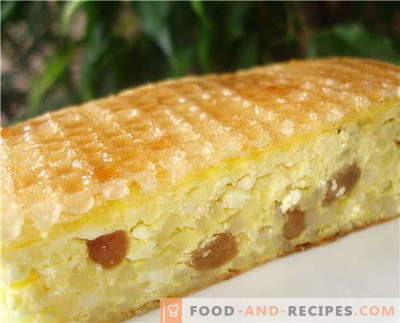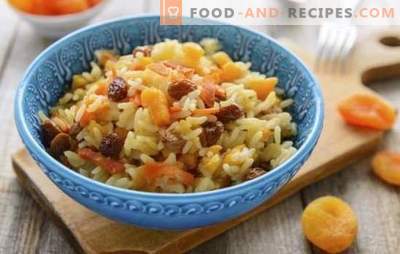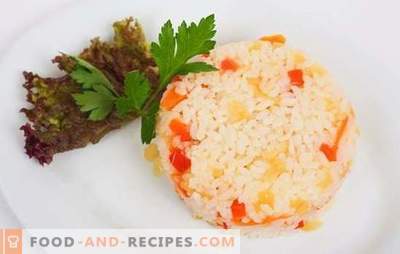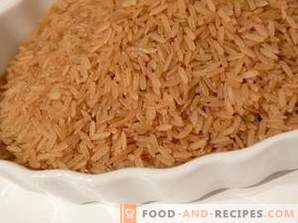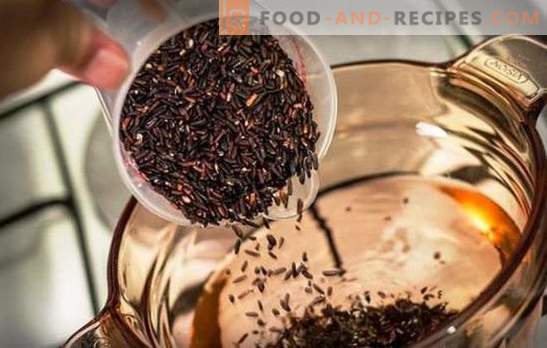
There are quite a few varieties of this cereal, but more often housewives of the European part of the continent use only a few varieties of white rice for cooking. At the same time, in Asian cuisine rice is presented in a wider and more varied assortment, since dishes from it are traditional in Asian countries.
What is the reason for such differences in varietal preferences, and what do Asian women know about rice that the Europeans do not know? Everything is relative, as popular wisdom says. Therefore, we will try to compare some of the usual white rice varieties with brown, unpolished varieties traditionally used in Asian cuisine, and not only in terms of healthy and wholesome food, but also the technology of its preparation.
How to cook brown rice - nutritional value and taste
To begin with, pay attention to the fact that brown rice is a whole, more natural grain, without grinding. The structure of rice grains, as well as all cereal crops, is about the same: the upper layers, covered with a harder shell, not counting the peel, contain niacin, thiamine, riboflavin, folic acid, a significant portion (70%) of mineral substances (potassium, magnesium, phosphorus, selenium, zinc) and up to 80-85% of valuable organic oils. Brown rice is rich in fiber, while it contains only 10% of vegetable protein. It has a beneficial effect on the protective functions of the body, improves the functioning of the nervous, circulatory and digestive systems. The brown rice surface shell gives it a characteristic color and a nutty shade on the palate.
After the collapse and polishing, rice grains acquire the white color that is familiar to the European population, transparent and not very much, depending on the variety, different sizes and shapes. Closer to the middle, in rice grain, according to its structure, carbohydrates are mainly located - up to 80%. The remaining 20% white grain contains the same vitamins and minerals as brown rice, but this ratio makes you think about choices and preferences. White rice has a neutral, habitual taste quite easily and quickly absorbs the taste of spices and all the ingredients of a dish during cooking, especially since it is cooked for 10-15 minutes.
How much to cook brown rice - cooking features
The speed of cooking white rice is its only significant advantage, because of which most people in European cities prefer to constantly include it in their diet. Brown rice does not tolerate haste, it is a product that needs to be cooked without fuss, and it is this philosophy that is more characteristic of Asian nations.
White rice will have the flavor that all ingredients added to the dish will give it, and the characteristic nutty note of brown rice is not lost, but makes you carefully select the ingredients to create a harmonious taste of the dish.
The only difficulty in cooking, if it can be considered a difficulty, is long soaking and washing brown rice. Directly during the cooking process, cooks and technologists advise, as a rule, to change the water twice and rinse the brown rice. The rest of his cooking is no different from cooking ordinary white rice. Unwashed cereal after washing and soaking stand for some time in clean and cool water (up to 10 hours). It is better to prepare brown rice in advance, putting soaking for the whole night. Especially long soaking of unpolished cereals is recommended for those dishes where, due to the technological features of cooking, it is impossible to drain and change water during the cooking process (rice, rice meatballs, stews with rice, casseroles). Rinsing during cooking can be used when brown rice is cooked as a side dish for meat or fish. By the way, the brown variety has one significant advantage over white rice: it does not boil soft, the dishes have a crumbly texture.
If you doubt that brown rice can be as tasty as usual, and the decision to include on the regular basis dishes of unpolished grits in the diet is taken, then consider several recipes where the taste difference will not be felt at all, and the nutritional value of the dish will be improved. while reducing calories consumed.
How much to cook brown rice with pumpkin on milk
Products:
- Pumpkin, nutmeg 150 g
- Sugar 50 g
- Salt 2 g
- Rice, unpolished 100 g
- Milk 350 g
- Ghee 75 g
Preparation Procedure:
For the night washed rice wet in water, as advised technologists. In the morning, boil it twice (5-7 minutes) in plenty of water, rinse and, drain the water, set aside. Cut the cleaned pumpkin into small cubes and pass in butter until half cooked. Add sugar to the pumpkin caramelized and lightly browned. In boiled milk, put boiled rice, roasted pumpkin and cook for five minutes. Bring to taste with salt and sugar. Remove the saucepan from the stove and wrap with a flannel napkin. After 20 minutes, breakfast is ready.
How to cook brown rice with apple and dried fruit
Composition of products:
- Green Apple, peeled 200 g
- Raisin 100 g
- Butter, melted
- Chipped peanuts (fried) 70 g
- Dried apricots 120 g
- Prunes, pitted 50 g
- Unpolished rice, boiled 300 g
- Sugar and salt to taste.
Cooking:
Boiled brown rice cooked the day before, put in a ceramic pan or distribute in portion pots, richly oiled. Peel the apple and the core, cut into cubes. Washed dried steamed with boiled water, finely chopped. Put a layer of dried fruit on rice, then apples. Sprinkle with chopped nuts. Cook sweet gravy from boiling water (1 cup) and sugar, and pour the rice in pots. Put them in the oven for baking at 180 ° C for 20 minutes. Before baking, cover the pots with lids or foil.
How much to cook brown rice with vegetables and meat
Ingredients:
- Carrot, yellow 150 g
- White onions 200 g
- Pepper, sweet 100 g
- Tomatoes 300 g
- Blue eggplants 120-150 g
- Chicken fillet 0.6 kg
- Unpolished rice 150 g
- Fresh greens 200 g
- Olive oil 150 ml
- Garlic 20 g
- Ground spices:
- coriander,
- chili,
- black pepper,
- Carnation,
- bay leaf
Preparation Procedure:
Wash and peel vegetables, greens, basil, parsley. Onions, eggplant (without skin) and lettuce pepper cut into cubes. Grate carrots. Blanch ripe tomatoes, peel and rub through a sieve.
Cut the prepared meat into cubes with a side of 1.5-2.0 cm.
Heat the oil in a skillet and fry the meat cubes. Put onions and carrots. Separately, in a pan, brown pepper and eggplant. Add them to the stewpot. Top with brown rice, pre-soaked and washed in cold water, distribute evenly.
Season tomato juice with spices, salt and pour into a saucepan. Add hot boiled water to cover 3 cm in the dish. Stew on low heat for 40 minutes. Serve the stew laid out on a large platter. Decorate with fresh chopped greens.
How to cook brown rice - useful tips
- Unpolished rice is stored much less than processed. For this reason, it is offered in retail networks in relatively small quantities. If you like to stock up with cereals for the future, then store the rice in a tightly closed glass container to protect it from extraneous smells, the penetration of bugs and excessive moisture.
- Add 2 cups of water to a glass of pre-soaked rice. If the moisture content of the cereal is too low, then the amount of water should be slightly increased. It is not recommended to add water to rice during cooking. If suddenly it becomes clear that the water is not enough, turn off the heat, close the lid and wrap the pan, leaving it so for a couple of hours: the water will not boil and evaporate uselessly, but will be absorbed into rice.
- Rice is boiled, tossed in both cold and hot water. In cold water, the cereal is cooked with the lid closed over low heat. From the point of view of preservation of nutritional properties in the product, this method of cooking is more useful. When lowering rice into boiling water, the lid of the pot is usually not closed. Salt rice should be no earlier than 10 minutes before readiness.
- If rice is needed for making sushi, choose a round variety for cooking. From it the necessary viscous consistence will turn out.
- The longer the grain of the rice, the more crumbly the side dish will be.
- If during the cooking of rice it is noticed that the water has become too turbid, this indicates a poor quality of grain - it is cracked and releases starch. To get in this case, though, a crumbly side dish, rather than a viscous porridge, add butter before the cereal sticks together. There is another way: remove the pan from the stove, drain the turbid water, fold the rice through a colander and rinse. Try the taste. Put the rice back in the pan, add a little boiling water to stew the side dish, put the butter, stir and put on low heat for 2-3 minutes, covered with a lid - rice will come.




